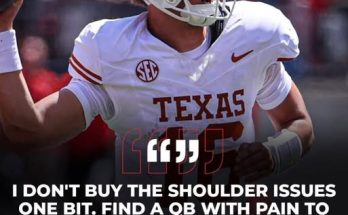In one of the most shocking developments of the 2025 college football recruiting cycle, a blue-chip 5-star recruit who had long been committed to Notre Dame has dramatically flipped his commitment to the Alabama Crimson Tide, sending ripples through the college football world. This stunning reversal not only stunned the Fighting Irish faithful but also left powerhouse programs Michigan, Georgia, and Ohio State, who were all vying aggressively for his signature, watching in disbelief. The recruit’s decision to choose Alabama over such storied programs speaks volumes about the shifting dynamics of college football recruiting and signals a major coup for the Crimson Tide as they continue their pursuit of dominance under head coach Nick Saban.
The recruit in question, a highly touted athlete rated among the nation’s elite, had been a cornerstone of Notre Dame’s 2025 recruiting class. For months, his commitment was celebrated as a defining moment for the Fighting Irish, a program that has been striving to regain national prominence and compete for championships consistently. His combination of size, athleticism, and skill on the field made him a coveted prize, and many believed his presence would provide a cornerstone for Notre Dame’s resurgence.
However, the college football landscape is notoriously volatile, especially in recruiting, where verbal commitments can be as fluid as the players’ ambitions and circumstances. The flip to Alabama shocked analysts, fans, and insiders alike because it not only disrupted Notre Dame’s recruiting plans but also showcased Alabama’s relentless ability to sway even the most seemingly solid commitments. Nick Saban’s program, renowned for its consistent pipeline of NFL-ready talent, has built an aura that is tough for even the most loyal prospects to resist.
The recruit’s decision came after a whirlwind final few weeks of recruitment. Despite a lengthy commitment to Notre Dame, his recruitment remained active behind the scenes, with Alabama making a final push that proved irresistible. The Crimson Tide offered him a vision that few programs could match: the chance to compete for national titles annually, train under one of the best coaching staffs in college football, and join a pipeline that has produced an unprecedented number of NFL stars.
What made the flip particularly shocking was the context of the other programs involved. Michigan, Georgia, and Ohio State are among the elite programs in college football, each with a tremendous legacy and recent success in recruiting. Michigan has surged under their dynamic coaching staff, with a national title to prove their rise. Georgia has solidified itself as a powerhouse with back-to-back championships and a pro-style development model, while Ohio State remains a perennial contender with a steady influx of high-profile talent. For the recruit to choose Alabama over these heavyweights signaled a shift in perception among top recruits, reaffirming Alabama’s magnetic pull in the sport.
Notre Dame fans, in particular, were left stunned and searching for answers. The Fighting Irish had counted on this recruit to be a foundational piece in their pursuit of national relevance, especially as they aim to return to the College Football Playoff on a regular basis. The program’s commitment to excellence and storied history made the original commitment feel like a perfect fit. But in the highly competitive world of recruiting, fit alone is rarely enough to hold onto the best athletes.
The recruit’s flip highlights several key themes in college football recruiting today. First, it underscores the tremendous influence Alabama continues to wield despite changes in the landscape, such as the NIL era and the transfer portal. Alabama’s culture of winning and player development remains one of the strongest selling points for elite prospects. The ability to prepare players for the NFL while competing for championships every season is a unique combination that few other programs can replicate.
Second, it illustrates the volatility and unpredictability of verbal commitments. In a world where social media, NIL deals, and constant interaction between prospects and programs have increased, verbal commitments are often just a starting point. Coaches and programs must continue to build relationships and offer compelling visions to maintain their commitments, knowing that the battle for top recruits is never truly over.
Third, it raises questions about Notre Dame’s recruiting strategy and its ability to compete with the likes of Alabama and other blue-blood programs on a consistent basis. Notre Dame has enjoyed periods of recruiting success, but this flip could signal the need for reassessment and adaptation in a landscape where traditional powers are no longer the only options for elite talent.
The recruit himself has remained relatively tight-lipped about his decision publicly, choosing instead to focus on the excitement of joining Alabama and the opportunity to compete at the highest level. Sources close to him say the decision came down to the chance to develop under Alabama’s coaching staff and the program’s unparalleled track record of preparing players for professional careers. The allure of the Crimson Tide’s winning culture, combined with the facilities and national exposure, ultimately tipped the scales.
For Alabama, this flip represents more than just the addition of another top recruit. It’s a statement to the rest of college football that their recruiting machine is still firing on all cylinders. Even programs with long-standing commitments from elite players are not safe from the Tide’s influence. This momentum will only bolster Alabama’s reputation as the place to be for the nation’s best talent.
The fallout from this flip will be felt far beyond just these programs. Rivalries between Alabama, Notre Dame, Michigan, Georgia, and Ohio State are fierce on and off the field, and recruiting battles have become a key front in those rivalries. This flip adds a new chapter to the ongoing saga of recruiting wars that help define the power structure of college football for years to come.
Recruiting experts have noted that the flip is emblematic of a larger trend in the sport: elite recruits are increasingly looking beyond regional ties or early commitments and focusing on the overall opportunity to compete at the highest level and maximize their potential.



